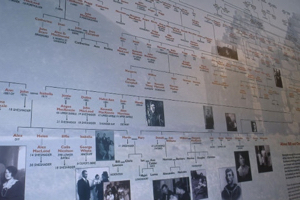Another brilliant piece from a GUNNAS WRITING MASTERCLASS writer
“You need to know, who your people are, what your culture is, and where you come from. If you don’t understand that about yourself, you’ll never understand it about us,” said the elderly Aboriginal man, who was doing his best to ‘educate’ me. Those words guided me to return to Tasmania, and to seek out as much time as possible with my last remaining grandparent, my paternal grandmother.
I discovered that I came from a colonial, Vandemonian family. Of course I was most attracted to the story that no-one wanted to tell – Gran’s mother’s family …. why did no-one want to speak about them? Gran’s mother, Annie Catherine, was universally loved and adored by her grandchildren. “She never liked to talk about her family”.
The mystery drew me in. I discovered a photo of her mother, Ada Amelia. It had been mistakenly identified as the “other” grandmother, Charlotte. But there was Charlotte, in the background. So the grandmother featured in this photo was not Charlotte, meaning it must have been Ada! My expertise in understanding our family was growing … I had discovered something that no-one else had.
Now to find Ada’s family. There was no birth record for her, but I found a family that seemed to fit. I contacted a descendent, who was also a family researcher. “No”, was his haughty retort. “You are not from our family, I’ve been contacted by your people before. Poor research. Please leave me alone”.
When I discovered the baptism records, for my Ada, and the haughty researcher’s ancestor, and two more siblings that he was not aware of, I wondered whether to share my discovery with him …. “Welcome to the family,” the haughty man said, without understanding that I did not need him to welcome me to my own family.
Now I had the name of Ada’s parents. This brought me face to face with the stories that had been buried. Ada’s mother Janet, not just a young convict, like so many in my family, but an alcoholic and a thief until her dying day. There were the newspaper records – the time that she abandoned Ada, aged three, with only her seven year old brother to fend for her; when Ada was five, the removal of Janet’s twin infants into state care; when Ada was six, her mother serving short prison sentences.
After Ada married and started her own family, there was her mother, following her to settle in a nearby town, and being arrested for petty crime over and over again. So this was what Annie Catherine was hiding, a grandmother bringing so much grief to the family. By the end of her life, none of Janet’s children cared for her. She died in an invalid institution and was buried in an unmarked pauper’s grave.
Yes, Janet had a hard life, she was abandoned herself, back in Dundee, Scotland – her father at sea, her mother in prison. Yes, she did the best she could. But how could Ada have borne it? How could she survive such a childhood? She must have been so damaged. And yet Ada raised Annie Catherine, universally loved, such a good woman. Ada broke the chain of neglect. She warmed her child with love, and brought her to a good life. Ada is my heroine, for what she did.
But, I was troubled by my feelings about Janet. Where was my solidarity with a woman who had clearly struggled?
So I went to Dundee, I walked the streets that young Janet walked – where she slept under the stairs with her friend, where she stole the shawl, where she hocked the shawl, where she bought the soup for them to eat, the place at the river where they washed their faces, the street where she was arrested, and the police station where she was imprisoned. Making that walk, I felt her as a young woman, who simply wanted to have a good life, but had no options.
The impact of tracing my family all the way back to Scotland, surprised me. Not only did I find peace with my great, great grandmother, but I now I had a visceral experience of “where my people came from”. We are not from Australia. Our time on this land is so fleeting, our roots are in other lands, far across the globe.












